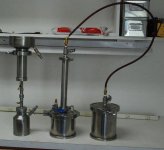Wow!!! I am never short of amazed by your work Grey Wolf, the Lil Terp is no exception...
Even though I am extremely happy with my Terpenator, I forsee myself building a Lil Terp for use in the "Enabler" configuration to supply alcohol for my Terp; not to mention having a unit perfectly suited for those preciously small "nug runs" not large enough to run the Terp.
I can't thank you enough for another great design GW; I feel like I should be sweeping up your shop floor and scrubbing toilets to get an apprenticeship like you have provided here...
Last and certainly least, I am a little confused by the area of a circle formula above; I thought Radius squared x pie = Area
Thanks for the good thoughts bro!
Pi X radius squared works, as does does .7854 Diameter squared. I just prefer to use the 78.54% of a square with the same width and height.
IE: A 10" circle would have an area of 78.54 square inches at 10 X 10 X .7854= 78.54.
5" radius X 5" radius X 3.14159 = 78.53975.


 You want US patents, go to the
You want US patents, go to the 
